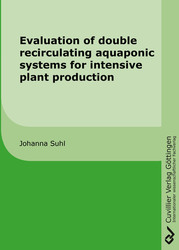| Areas | |
|---|---|
| Serie de libros (96) |
1378
|
| Nachhaltigkeit |
3
|
| Gesundheitswesen |
1
|
| Letra |
2364
|
| Ciencias Naturales |
5406
|
| Matemática | 229 |
| Informática | 319 |
| Física | 980 |
| Química | 1363 |
| Geociencias | 131 |
| Medicina humana | 243 |
| Estomatología | 10 |
| Veterinaria | 108 |
| Farmacia | 147 |
| Biología | 835 |
| Bioquímica, biología molecular, tecnología genética | 121 |
| Biofísica | 25 |
| Nutrición | 45 |
| Agricultura | 1004 |
| Silvicultura | 201 |
| Horticultura | 20 |
| Ecología y conservación de la tierra | 148 |
| Ciencias Ingeniería |
1793
|
| General |
98
|
|
Leitlinien Unfallchirurgie
5. Auflage bestellen |
|
Erweiterte Suche
Evaluation of double recirculating aquaponic systems for intensive plant production (Tienda española)
Johanna Suhl (Autor)Previo
Indice, PDF (580 KB)
Lectura de prueba, PDF (640 KB)
Double recirculating aquaponic systems (DRAPS) were developed as sustainable food production system and as alternative to conventional aquaculture and hydroponics. DRAPS allow the production of fish and plants under specific optimal conditions. One major subject of the present study was the comparison of vegetable production in DRAPS with conventional hydroponic production. For investigations Nile tilapia and African catfish were combined with tomatoes or lettuce. Furthermore, the connection point between fish and plants was studied in more detail to identify possible weaknesses of this point. Additional, the fertiliser and fresh water saving potential and the environmental relive by replacing nitrogen fertiliser by fish waste water was investigated. The results of this study demonstrate clearly the competiveness of DRAPS with conventional hydroponic systems in terms of plant quantity and quality aspects as well as sustainability issues. DRAPS is a highly promising system which must be investigated and improved further. Finally, it will contribute significantly to sustainable intensification and consequently to food safety.
| ISBN-13 (Impresion) | 9783736971592 |
| ISBN-13 (E-Book) | 9783736961593 |
| Formato | A5 |
| Idioma | Inglés |
| Numero de paginas | 276 |
| Laminacion de la cubierta | mate |
| Edicion | 1. |
| Lugar de publicacion | Göttingen |
| Fecha de publicacion | 05.03.2020 |
| Clasificacion simple | Tesis doctoral |
| Area |
Agricultura
Plantación Produccion precuaria Horticultura |
| Palabras claves | Double recirculating aquaponic system, Doppelt rezirkulierendes Aquaponiksystem, DRAPS, Decoupled aquaponics, Hydroponics, Hydroponik, Aquaponics, Aquaponik, Tomatoes, Intensive plant production, Lettuce, Sustainable intensification, Recirculating aquaculture system, RAS, Oxygen, Single recirculating aquaponic system, Einfach rezirkulierendes Aquaponiksystem, Fish, Fisch, African catfish, Afrikanischer Raubwels, Clarias, Tilapia, Sustainability, Nachhaltigkeit, Environmental protection, Nitrification, Nitrifikation, INAPRO, Fertilizer use efficiency, Düngernutzungseffizienz, Fertilizer saving, Water use efficiency, Wassernutzungseffizienz, Nutrient film technique, Nährfilmtechnik, Vegetable, Gemüse, Secondary metabolites, Sekundärmetabolite |
| URL para pagina web externa | https://fakultaeten.hu-berlin.de/de/lewi/ |








